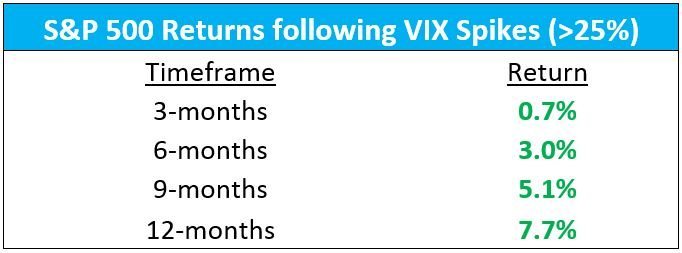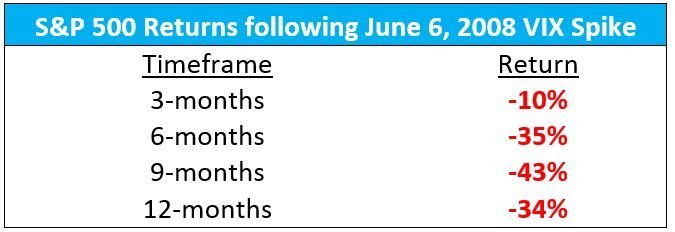Volatility – a.k.a. the VIX – and the super-charged “volatility ETFs” we trade in my Project V research service have been hot topics in the media this month.
Even before last Wednesday’s massive 46% spike in the VIX – the seventh-largest one-day spike ever for the index – “volatility” had become the subject du jour.
Not because volatility was high… or increasing… or spiking.
But because every financial pundit and his brother was writing about how low the VIX has been (before last Wednesday’s move, of course)…
How “quiet” the market was…
How “complacent” investors had become.
“The VIX is under 10 now, its lowest reading since December 2006,” read one piece.
Another commentary riffed off Franklin D. Roosevelt’s famous quote, twisting it to say: “The only thing we have to fear now is the lack of fear in the market today.”
Cute!
But for all the ink commentators have spilled on the topic, I have yet to read one piece that presciently warned of last Wednesday’s move (before the move).
And I have yet to read a single piece that tells investors exactly what they should do now… now that volatility is back.
Today, I hope to fill that void… to go beyond cute commentary on the VIX to give you my best actionable advice on what to do now.
After all, I’m a strategist, not a commentator, so strategic, actionable advice is what our premium subscribers pay me to give.
Here’s a peek at some of my best research on volatility booms and busts…
Ten Days After a VIX Spike
Most people’s instincts told them to sell stocks in the immediate aftermath of last week’s spike in the VIX.
The natural assumption is that a volatility spike like that, and corresponding stock market selloff, is just the beginning of more bad things to come.
But that’s typically wrong…
You see, contrary to the gut feel of most investors, stocks are more likely to rise in the 10 days following a large VIX spike.
And volatility is more likely to ease lower over those 10 days.
I ran a simple study to come to that conclusion.
I looked at historical instances of one-day VIX spikes greater than 25%, of which there are only 33 in the history of the index.
Ten days following those one-day spikes:
- The S&P 500 was higher 55% of the time, gaining an average of 0.3%
- The VIX was lower 72% of the time, losing an average of 6.2%
What’s more, a big drop in the VIX typically follows soon after a big spike.
Of all the historical instances of a VIX spike greater than 25%… 83% of the spikes were followed by a 10% or greater single-day drop… within the next 10 days.
Moral of the story is: you shouldn’t sell after a VIX spike… you should BUY!
That’s how I positioned the founding members of my Project V service, in the immediate aftermath of last Wednesday’s move.
So not only did we make a 10.4% profit in a single day, during the VIX spike… we also made 12.9% over the next three days, by positioning for higher stock prices and lower volatility.
It took a healthy dose of bravery to make those trades… but backed by the hard statistics of my research, it was the right thing to do. And we profited nicely from it.
Of course, unless you’re using a system like the one I share in Project V… you probably shouldn’t be trading volatility on such a short timeframe.
Still, you should know what last week’s massive VIX spike means to you.
In two words: don’t sell!
I extended the study I shared above, looking at the historical instances of VIX spikes greater than 25%.
Here’s what the S&P 500 has returned, on average, over the following three to 12 months…

Not so scary, eh?
Although I have one final point to make…
That is, averages tend to hide the outliers.
So, while positive stock markets returns tend to follow large VIX spikes, on average, that isn’t always the case.
In 2008, the VIX spiked 26.4% on June 6. Buying the S&P 500 following that move was quite costly, as you can see here:

Ouch!
Of course, those are the returns you’d get as a “buy-and-hold” investor. And we’re no fans of buy-and-hold, here at Dent Research.
Instead, we rely on time-tested, active trading systems… strategies that allow us to adapt to changing market conditions, benefitting from the markets booms and its busts.
Project V is no different. I specifically designed it to be nimble… and to take advantage of the lucrative profit opportunities in volatility booms and busts.
And my Project V market-timing model absolutely raked it in during the 2008 crash…
This service is currently only available to founding members, but we’ll be opening up to new readers later this summer. Stay tuned for more on this.
In the meantime, don’t be scared off by last week’s VIX spike. It’s more likely than not to be a one-day dust up… followed by positive stock market returns ahead.
To good profits.
The content of our articles is based on what we’ve learned as financial journalists. We do not offer personalized investment advice: you should not base investment decisions solely on what you read here. It’s your money and your responsibility. Our track record is based on hypothetical results and may not reflect the same results as actual trades. Likewise, past performance is no guarantee of future returns. Certain investments such as futures, options, and currency trading carry large potential rewards but also large potential risk. Don’t trade in these markets with money you can’t afford to lose. Delray Publishing LLC expressly forbids its writers from having a financial interest in their own securities or commodities recommendations to readers.
Recommended Content
Editors’ Picks
How will US Dollar react to Q1 GDP data? – LIVE

The US' GDP is forecast to grow at an annual rate of 2.5% in the first quarter of the year. The US Dollar struggles to find demand as investors stay on the sidelines, while waiting to assess the impact of the US economic performance on the Fed rate outlook.
EUR/USD holds gains above 1.0700, as key US data loom

EUR/USD holds gains above 1.0700 in the European session on Thursday. Renewed US Dollar weakness offsets the risk-off market environment, supporting the pair ahead of the key US GDP and PCE inflation data.
GBP/USD extends recovery above 1.2500, awaits US GDP data

GBP/USD is catching a fresh bid wave, rising above 1.2500 in European trading on Thursday. The US Dollar resumes its corrective downside, as traders resort to repositioning ahead of the high-impact US advance GDP data for the first quarter.
Gold price edges higher amid weaker USD and softer risk tone, focus remains on US GDP

Gold price (XAU/USD) attracts some dip-buying in the vicinity of the $2,300 mark on Thursday and for now, seems to have snapped a three-day losing streak, though the upside potential seems limited.
XRP extends its decline, crypto experts comment on Ripple stablecoin and benefits for XRP Ledger

Ripple extends decline to $0.52 on Thursday, wipes out weekly gains. Crypto expert asks Ripple CTO how the stablecoin will benefit the XRP Ledger and native token XRP.